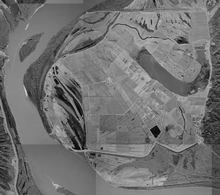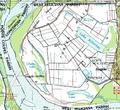- Louisiana State Penitentiary
-
 Entrée principale de la prison - La plaque dit "Louisiana State Penitentiary" et "Warden Burl Cain" (Directeur Burl Cain)[1]
Entrée principale de la prison - La plaque dit "Louisiana State Penitentiary" et "Warden Burl Cain" (Directeur Burl Cain)[1]
Le Louisiana State Penitentiary ou LSP (« Pénitencier d’État de Louisiane », appelé aussi Angola) est une prison américaine située dans la Paroisse de Feliciana Ouest, Louisiane, géré par le Louisiana Department of Public Safety and Corrections[2].
Avec un surperficie de 73 km², dans lequel 75% des quelque 5 000 détenus sont noirs (gardés par pas moins de 1 800 gardiens)[3]. C’est la plus grande prison de haute sécurité des États-Unis[4].
Louisiana State Penitentiary est la seule prison habilitée a appliquer la peine de mort en Louisiane, le couloir de la mort pour les hommes et la chambre d'exécution s’y trouvent[5],[6]. Le couloir de la mort pour les femmes est situé dans les locaux du Louisiana Correctional Institute for Women (LCIW) á St. Gabriel[7].
Louisiana State Penitentiary possède un musée, le « Angola Museum »[8].
Les prisonniers pratiquent le rodéo à Angola[9], les droits d’entrée du spectacle qui se déroule dans l’enceinte même de la prison permettent aux détenus de financer des programmes d’insertion.
Sommaire
Histoire
Le site était autrefois occupé par une ancienne plantation (d’ou le nom de « The Farm »), dont la plupart des esclaves y travaillant était originaires de l’Angola en Afrique australe. À la fin du XIXe et début XXe siècles, l’État de Louisiane achète un certain de ces plantations pour les reconvertir en pénitenciers. Ceux-ci opérèrent alors toujours le même style de plantation. Les prisonniers y effectuaient un travail épuisant, moissonnant le coton, la canne à sucre, et d'autres récoltes de l'aube au crépuscule.
C’est dans ce cadre qu’en 1901, le Louisiana State Penitentiary est ouvert[10]. En 1961, le Louisiana Correctional Institute for Women (LCIW) est inauguré à son tour, les femmes qui sont alors détenues à Angola ont été déplacés à LCIW[11].
En 2001, les créateurs d’À l'ombre de la haine filmaient les scènes de la prison dans le Louisiana State Penitentiary[12].
Galerie
Liens internes
Notes
- Clément, Éric. "Burl Cain: le directeur envoyé par Dieu." Cyberpresse. 11 avril 2009. Consulté le 24 août 2010.
- "Louisiana State Penitentiary." Louisiana Department of Public Safety and Corrections. Consulté le 25 août 2010.
- Clément, Éric. "La prison d'où l'on ne sort pas vivant... ou presque." Cyberpresse. 11 avril 2009. Consulté le 26 août 2010
- "Le rodéo des condamnés." Radio Télévision Suisse. 13 avril 2006. Consulté le 25 août 2010.
- "Photo Album." Louisiana State Penitentiary. Consulté le 20 juillet 2010.
- "Officials prep for Bordelon's execution Thursday." The Advocate. 6 janvier 2010. Consulté le 24 août 2010. "Laborde said Bordelon has been moved from Angola's new Death Row facility to a cell at nearby Camp F, where the execution chamber is located"
- "Classification–Where Inmates Serve Their Time." Inside the System: How Inmates Live and Work. Louisiana Department of Public Safety & Corrections. 14/40. Consulté le 30 juin 2010.
- "Angola Museum.' Louisiana State Penitentiary. Consulté le 30 août 2010.
- Clément, Éric. "Un rodéo contesté." Cyberpresse. 11 avril 2009. Consulté le 30 août 2010.
- "Time in Prison." Louisiana Department of Public Safety & Corrections. 32/40. Consulté le 23 septembre 2010.
- "LOUISIANA CORRECTINS TIMELINE."(sic) The Advocate. 12 mars 2000. News 13A. Consulté le 29 août 2010. "1961 Louisiana Correctional Institute for Women opened in an old prison farm camp at St Gabriel with female prisoners moved from Angola..."
- Wuntch, Philip. "Raging 'Ball' Anger and tears came with the role for star Halle Berry." The Dallas Morning News. 3 février 2002. Consulté le 1 septembre 2010. "All our prison scenes were filmed in Angola [at the Louisiana State..."
Liens externes
- Louisiana State Penitentiary (en)
- Prison View Golf Course (en)
- "Angola, la prison." Cyberpresse. 11 avril 2009
- Faure, Guillemette. "Jour de fête dans une prison de Louisiane." Le Figaro. 15 octobre 2007
Wikimedia Foundation. 2010.





